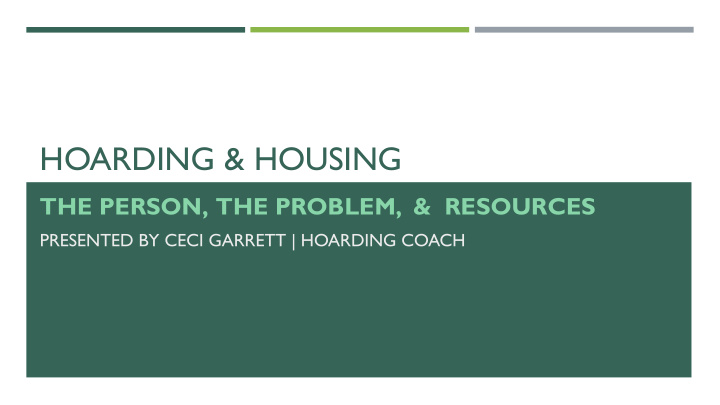



HOARDING & HOUSING THE PERSON, THE PROBLEM, & RESOURCES PRESENTED BY CECI GARRETT | HOARDING COACH
GOALS : • RECOGNIZE HOARDING AS A MENTAL HEALTH ISSUE • BE ABLE TO DISTINGUISH BETWEEN CLUTTER, COLLECTING, & HOARDING • UNDERSTAND THE USE OF HARM REDUCTION PRACTICES IN HOARDING (C) 2018 CECI GARRETT
“ I’d never considered that there was something going on inside her, in her brain, in her heart, in her soul. The visible clutter was simply an exterior representation of an interior chaos I’d never been privy to. There was so much more to my mother’s hoarding than I knew.” - Ceci Garrett, “Hoarding as a Mental Health Issue” TedxSpokane 2015 SEE THE PERSON, SOLVE THE PROBLEM SEE THE STUFF, MISS THE SOLUTION (C) 2018 CECI GARRETT
Hoarding Disorder (HD) • DSM-5 (2013) • Characterized by: Difficulty discarding Strong urges to save items Congestive clutter Distress and/or impaired functioning Excessive acquiring o Poor insight o • Reasonable Accommodation • Treatment (C) 2018 CECI GARRETT
Clutter vs. Hoarding (C) 2018 CECI GARRETT
HARM REDUCTION IN HOARDING A set of pragmatic principles and compassionate strategies designed to minimize the harmful consequences of high-risk behaviors to the individual with the behavior and the public-at- large (C) 2018 CECI GARRETT
Why harm reduction? Efforts to deal with hoarding are resource-heavy Expensive — mass cleanouts average $2-5K/day Time-consuming — effective in-home treatment/support can take months to years Marginal success rates (traditional clinical treatment offers only 1 in 3 success rate) Avoiding rebound hoarding Addresses personal health and safety issues Protects public health and safety Typically more agreeable to client (C) 2018 CECI GARRETT
Principles of Harm Reduction First, do no harm Primary goal is safety/health, and not to stop all hoarding behaviors Highly personalized to client and situation Client/resident is an ESSENTIAL part of the Harm Reduction team Change is slow and failures often occur but do not mean the plan is failing Clients can make positive changes while hoarding continues to occur (C) 2018 CECI GARRETT
Components of Harm Reduction Plan Uniform Inspection Checklist Identify environmental risks Evaluate client challenges and resources • Physical • Psychological • Social Formulate Harm Reduction team • Client/Resident • Property Management • Social Worker/Case Manager • Family members, friends • Code Enforcement, Public/Environmental Health, Fire Department, if needed Prioritization of goals by team (C) 2018 CECI GARRETT
REFERENCES: Bratiotis, C., Schmalisch, C. S., & Steketee, G. (2011). The hoarding handbook: A guide for human service professionals . New York: Oxford University Press. Tolin, D. F., Frost, R. O., & Steketee, G. (2014). Buried in treasures: Help for compulsive acquiring, saving, and hoarding . Oxford: Oxford University Press. Tompkins, M. A. (2009). Digging out: Helping your loved one manage clutter, hoarding & compulsive acquiring . Oakland, CA: New Harbinger Pub. (C) 2018 CECI GARRETT
RESOURCES: Coaching, Speaking, Harm-Reduction Plans Ceci Garrett || ceci@cecigarrett.com || 509-844-8104 Hoarding Clean Outs (Biohazard involvement) Steri-Clean Washington || steri-clean.com (C) 2018 CECI GARRETT
Recommend
More recommend